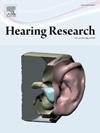Rational design of a Lfng-enhancer AAV construct drives specific and efficient gene expression in inner ear supporting cells
IF 2.5
2区 医学
Q1 AUDIOLOGY & SPEECH-LANGUAGE PATHOLOGY
引用次数: 0
Abstract
Achieving cell-specific gene expression is crucial in the design of safe and efficacious gene therapies for the treatment of sensorineural hearing loss. Although a variety of adeno-associated virus (AAV) serotypes have been used to deliver genes to inner ear hair cells, few serotypes currently allow specific targeting of supporting cells. We sought to specifically target supporting cells by combining an AAV serotype with high tropism for the inner ear with enhancer sequences from the supporting cell-specific gene Lunatic Fringe (Lfng). We identified three candidate Lfng enhancer sequences using bioinformatic analysis to identify accessible chromatin and histone marks associated with active transcription of the Lfng locus in supporting cells. Candidate Lfng enhancers or the ubiquitous CBh promoter driving an EGFP reporter gene were packaged into the AAV-ie capsid, and the virus was introduced into the inner ear of neonatal mice. AAV-CBh-EGFP transduced multiple sensory and non-sensory inner ear cell types, as well as cells in the brain. One of the three Lfng enhancers gave robust EGFP expression in border cells, inner phalangeal cells, pillar cells, and all three rows of Deiters' cells along the entire cochlear duct, as well as in vestibular organ supporting cells. Significantly, no fluorescently labeled cells were detected in the brains of mice injected with this virus. We further designed an AAV-Lfng-CreERT2 vector that drove strong recombination in Cre reporter mice supporting cells after tamoxifen treatment. Our results provide a tool to specifically target supporting cells of the juvenile and adult inner ear.

合理设计lfeng增强子AAV结构,驱动内耳支持细胞特异性和高效的基因表达。
实现细胞特异性基因表达对于设计安全有效的基因疗法治疗感音神经性听力损失至关重要。尽管多种腺相关病毒(AAV)血清型已被用于将基因传递到内耳毛细胞,但目前很少有血清型允许特异性靶向支持细胞。我们通过将具有内耳高趋向性的AAV血清型与来自支持细胞特异性基因Lunatic Fringe (lfg)的增强子序列相结合,寻求特异性靶向支持细胞。我们利用生物信息学分析确定了三个候选Lfng增强子序列,以确定与支持细胞中Lfng位点活性转录相关的可接近的染色质和组蛋白标记。候选Lfng增强子或普遍存在的CBh启动子驱动EGFP报告基因被包装到AAV-ie衣壳中,并将病毒引入新生小鼠的内耳。AAV-CBh-EGFP转导了多种感觉和非感觉内耳细胞类型,以及大脑细胞。三种Lfng增强剂中的一种在沿整个耳蜗管的边界细胞、指骨内细胞、柱细胞和所有三行Deiters细胞以及前庭器官支持细胞中都有稳健的EGFP表达。值得注意的是,在注射了这种病毒的小鼠大脑中没有检测到荧光标记的细胞。我们进一步设计了aav - lfeng - creert2载体,该载体在他莫昔芬治疗后的Cre报告小鼠支持细胞中驱动强重组。我们的结果提供了一个工具,专门针对青少年和成年内耳的支持细胞。
本文章由计算机程序翻译,如有差异,请以英文原文为准。
求助全文
约1分钟内获得全文
求助全文
来源期刊

Hearing Research
医学-耳鼻喉科学
CiteScore
5.30
自引率
14.30%
发文量
163
审稿时长
75 days
期刊介绍:
The aim of the journal is to provide a forum for papers concerned with basic peripheral and central auditory mechanisms. Emphasis is on experimental and clinical studies, but theoretical and methodological papers will also be considered. The journal publishes original research papers, review and mini- review articles, rapid communications, method/protocol and perspective articles.
Papers submitted should deal with auditory anatomy, physiology, psychophysics, imaging, modeling and behavioural studies in animals and humans, as well as hearing aids and cochlear implants. Papers dealing with the vestibular system are also considered for publication. Papers on comparative aspects of hearing and on effects of drugs and environmental contaminants on hearing function will also be considered. Clinical papers will be accepted when they contribute to the understanding of normal and pathological hearing functions.
 求助内容:
求助内容: 应助结果提醒方式:
应助结果提醒方式:


